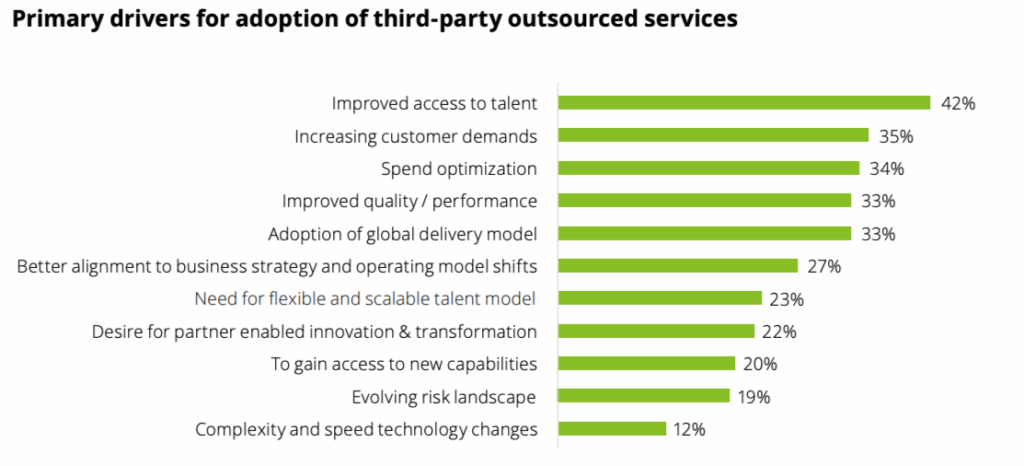Strategically, outsourcing now is a way to access specialized expertise (like AI/ML, GenAI, Advanced Analytics, IIoT, microservices, etc.) that a company lacks to some extent or has no experience at all. Those IT services providers who have an elaborate talent sourcing strategy allow companies of any scale to tap into their pool of skilled experts that is continuously growing or improving.
Among other reasons why most companies often lean to outsourcing are prioritizing access to advanced technologies (75% of organizations), cost efficiency (69%), and service optimization (56%).
In this post, we will help you peek into successful cases of outsourcing that well-known brands leverage. Google, Apple, Microsoft, Slack, WhatsApp, IBM – this is only the beginning of a long list of renowned tech companies that used or are still able to use outsourcing to be ahead of their competitors.
Why Do Organizations Outsource Their Business Operations to Vendors?
32% of organizations claim they have multiple vendors for different business operations
However, even the most committed vendor will fail short if a company is unwilling or not ready to integrate an external team with their existing operating model. That is one of the reasons why limitations and concerns toward outsourcing appear. Some of them stem from the company’s ineffective management strategy and inability to track and analyze value from the delivered services (according to Deloitte’s Survey 2024).
Still, many companies admit that any of such constraints can be addressed with a suite of intelligent tools for remote work, reporting, change management, and performance monitoring. Not mentioning agile methodology, result-driven approaches and best practices for the software delivery upon business needs and requirements.
Anyway, from emerging startups to acclaimed enterprises, each has its own reasons to outsource:
- Startups and small businesses will most likely vote for cost savings compared to having in-house teams. Faster speed of development due to collaboration with an external team that has a large portfolio of completed projects cross-industry. Enhanced access to talents globally (42% of organizations mention this as their primary driver for outsourcing services), flexibility, and scalability on demand.
- Mid-scale companies are looking for cost optimization (34%), ability to bridge the gaps in their in-house team’s expertise, improve their operational efficiency (27%), deliver products/services globally (33%), and bring innovative technology competencies and digital transformation initiatives.
- Enterprises and corporations also tap into non-core functions outsourcing. Having more focused objectives, they engage third-party vendors to enable scaling and continuity of their business operations 24/7 across different regions, facilitate integration of AI capabilities (83% of organizations expect that), cybersecurity, and risk management practices.

If you are looking for more details on such perks, go check this essential guide on 10 outsourcing advantages.
Top Enterprises that Outsource Their IT Operations to IT Service Companies
Even such tech giants like Google seek ways to slash costs, often outsourcing their IT operations to entirely different locations. With a Gen AI surge, this approach allows spotting exceptional talents across the globe. Sure, Google’s large partner network and a plethora of third-party vendors on tap make sourcing such valuable experts less strenuous.
Typically, Google has outsourced predominantly non-core operations like IT infrastructure management, software quality assurance, customer support, and maintenance to their extensive network of third-party providers. However, not so long ago, Google laid off employees of core teams to outsource their roles to developers with lower rates in Mexico and India. Perhaps, Gen AI-facilitated development makes many companies view outsourcing as a way to capitalize on geographically dispersed AI-driven talents.
AI and cloud competition is eye-opening, and Google managed to boost its profits by 30%, while its operating income grew by 31% in Q4 2024, leading in AI innovations, cloud, and streaming offerings.
Estimated benefits
- Scalability: extending teams for the peak periods
- Faster onboarding: engaging tech specialists of third-party vendor in weeks compared to months for recruiting in-house employees
- Rerouting internal engineers to high-value cloud infrastructure enhancement and AI solutions development.
Microsoft
Similar approach to outsourcing uses Microsoft. They have a hub of partners and external vendors in every country who advocate for Microsoft solutions to their clients. Microsoft relies on tried-and-tested vendors, who are either recognized as their certified solution partners, Microsoft Azure MSPs, co-sellers, or are on the way to that designation.
Since, terms and conditions of outsourcing services are strictly regulated by SLAs, NDAs, and partnership agreements, Microsoft exploits outsourcing to its full extent on their specific demand.
For example, one of their long-standing GSI partner Wipro adds value to Microsoft’s innovation centers, boosting AI and ML development, co-building and co-implementing solutions for their clients. They also obtain over a dozen advanced specializations across diverse Microsoft product categories.
This is only one of many partners, already market leaders, who support Microsoft. However, there are also many local trusted companies in every country where Microsoft has its offices. And as we know, setting up new partnerships is often reciprocal.
Estimated benefits:
- Genuinely global coverage, covering all time zones
- Legacy software modernization and enhancement
- Flexibility in software and hardware products development (external providers’ teams can be easily plugged in to a project of any scale having relevant certifications and confirmed expertise through the Partner’s center)
- Extended opportunities for an AI and ML innovation center, having access to engineering minds across the world
- Cost-savings due to delegated operational burden (data centers, infrastructure management, service desk operations, etc.)
- Reward partner programs guarantee high partners’ engagement and promotional opportunities
IBM
While IBM is an outsourcing provider, it also outsources its software development to countries like India with much lower labour costs compared to the U.S. Essentially, IBM outsourced its legacy infrastructure (on-premises servers, data centers, etc,) their maintenance and support to its subsidiary Kyndryl. It’s also responsible for network management and different types of IBM’s servers worldwide. There’s also a close collaboration between Infosys, TCS, and HCS that not only grows their competencies around IBM Cloud but also provides management of IBM’s hybrid cloud and collaborates with IBM on shared projects for clients in different domains.
- Redirection of strategic resources to AI solutions development, cloud computing, and consulting
- Dynamic adjustment of support and maintenance levels
- Continuous infrastructure monitoring and minimized downtime
- Business resilience due to comprehensive disaster recovery planning
Slack
Starting from hosting and infrastructure management to application performance monitoring and customer support, Slack is fearless, outsourcing its key IT operations to third-party providers. The company began its story by outsourcing the core application development to an external provider. The success results of the company are undeniable – over 38 million of active daily users. Hence, for Slack, outsourcing its IT operations to trusted vendors is a matter of continuous growth and future scalability. Their choice of such providers is thoroughly picked and managed. Like with Datadog, for example, used by Slack for the application performance monitoring and offered as an integrated service for Slack users.
Before WhatsApp became a part of Meta, it entirely ran on IBM’s infrastructure, including outsourced hosting, data storage, and data centers. During its evolution, WhatsApp has fully outsourced its content delivery, traffic optimization (third-party CDM and network services), customer support services, APIs (Twilio and Zendesk), and even app performance monitoring (Nagios, Monit tools). Cloudflare was used to ensure protection of WhatsApp messages against DDoS attacks. Now, it’s the Signal Foundation that ensures end-to-end encryption of WhatsApp messages using an integration of Signal Protocol. As a result of this smart outsourcing strategy and further advancements, WhatsApp ranks as a #1 most popular messaging platform in the world with 2 million active users per month.
Alibaba
Now a true tech mastermind (e-commerce, cloud provider, logistics, fintech), but in its early days, Alibaba heavily relied on outsourced website design and development. At present, Alibaba still uses outsourcing as a way to support its IT operations globally in terms of:
- Alibaba Cloud infrastructure (data centers across Europe, Asia, North America) – with providers like Equinix and Global Switch
- Though Alibaba has own CDN, they also partner with Cloudflare to eliminate data transfer fees for its e-commerce sites outside China
- Alibaba’s e-commerce platforms are equipped with DigiCert’s SSL/TLS certificates allowing for compliance with local regulations across the globe
- In terms of logistics beyond China, Alibaba teams up with DHL, UPS, FedEx, Maersk, etc. for fast delivery and shipping.
Spotify
In a music streaming world, Spotify, a leading music platform, takes 31,7% of all market share (subscribers proportion), having more than 200 million subscribers to premium plans and surpassing such a competitor as Apple Music by 2X in annual subscriptions. Outsourcing its critical operations, Spotify can focus on its business model development and effective upscaling. Among such operations are:
- Cloud infrastructure, which is now fully managed by GCP (data storing, computing, scalability, ML service) – a 300% computing efficiency increase!
- For content delivery network services (fast audio/video delivery to listeners), Spotify uses Fastly and Akamai solutions that bring rapid content caching and lower buffer rates.
- Subscription payments and in-app purchases are often performed using Adyen, Stripe, Apple/Google Play.
- Customer support is outsourced to local customer providers in Asia, Europe, Latin America, etc.
Conclusion
While 57% of tech leaders admit that recruiting IT talent is a complicated venture, the skills gap is gradually growing with the range of emerging technologies. Outsourcing in this case is one of those tried-and-tested solutions by top companies like Google, Microsoft, IBM that brings tangible results. Though many used outsourcing heavily in their early days to address their software engineering and development needs, currently most of these companies stick to more selective outsourcing (either developing some product features or delegating some IT operations like cloud infrastructure hosting). In any case, outsourcing is still a viable approach to software development and IT operations management. Let’s discuss where Svitla Systems can add value to your business.





